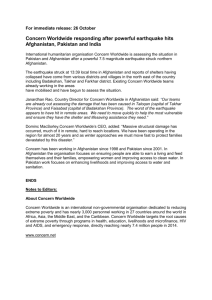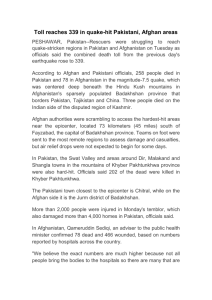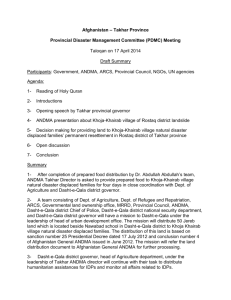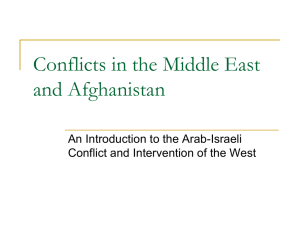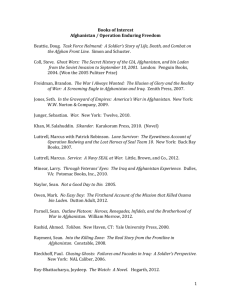afghanistan_annual_plan_2014
advertisement
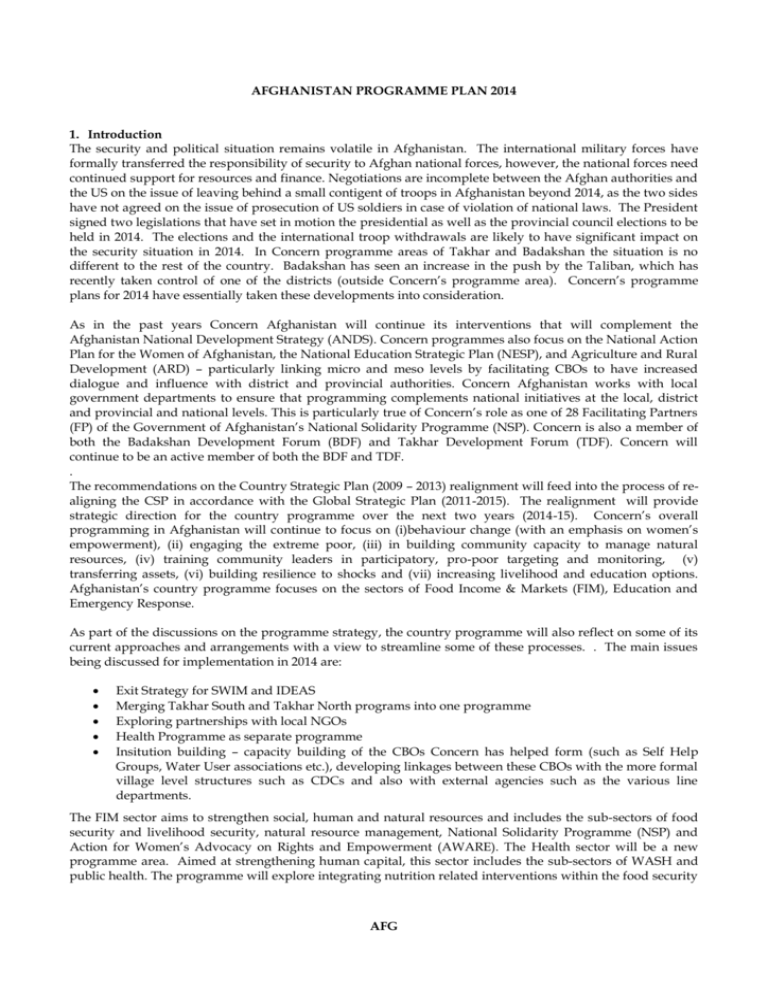
AFGHANISTAN PROGRAMME PLAN 2014 1. Introduction The security and political situation remains volatile in Afghanistan. The international military forces have formally transferred the responsibility of security to Afghan national forces, however, the national forces need continued support for resources and finance. Negotiations are incomplete between the Afghan authorities and the US on the issue of leaving behind a small contigent of troops in Afghanistan beyond 2014, as the two sides have not agreed on the issue of prosecution of US soldiers in case of violation of national laws. The President signed two legislations that have set in motion the presidential as well as the provincial council elections to be held in 2014. The elections and the international troop withdrawals are likely to have significant impact on the security situation in 2014. In Concern programme areas of Takhar and Badakshan the situation is no different to the rest of the country. Badakshan has seen an increase in the push by the Taliban, which has recently taken control of one of the districts (outside Concern’s programme area). Concern’s programme plans for 2014 have essentially taken these developments into consideration. As in the past years Concern Afghanistan will continue its interventions that will complement the Afghanistan National Development Strategy (ANDS). Concern programmes also focus on the National Action Plan for the Women of Afghanistan, the National Education Strategic Plan (NESP), and Agriculture and Rural Development (ARD) – particularly linking micro and meso levels by facilitating CBOs to have increased dialogue and influence with district and provincial authorities. Concern Afghanistan works with local government departments to ensure that programming complements national initiatives at the local, district and provincial and national levels. This is particularly true of Concern’s role as one of 28 Facilitating Partners (FP) of the Government of Afghanistan’s National Solidarity Programme (NSP). Concern is also a member of both the Badakshan Development Forum (BDF) and Takhar Development Forum (TDF). Concern will continue to be an active member of both the BDF and TDF. . The recommendations on the Country Strategic Plan (2009 – 2013) realignment will feed into the process of realigning the CSP in accordance with the Global Strategic Plan (2011-2015). The realignment will provide strategic direction for the country programme over the next two years (2014-15). Concern’s overall programming in Afghanistan will continue to focus on (i)behaviour change (with an emphasis on women’s empowerment), (ii) engaging the extreme poor, (iii) in building community capacity to manage natural resources, (iv) training community leaders in participatory, pro-poor targeting and monitoring, (v) transferring assets, (vi) building resilience to shocks and (vii) increasing livelihood and education options. Afghanistan’s country programme focuses on the sectors of Food Income & Markets (FIM), Education and Emergency Response. As part of the discussions on the programme strategy, the country programme will also reflect on some of its current approaches and arrangements with a view to streamline some of these processes. . The main issues being discussed for implementation in 2014 are: Exit Strategy for SWIM and IDEAS Merging Takhar South and Takhar North programs into one programme Exploring partnerships with local NGOs Health Programme as separate programme Insitution building – capacity building of the CBOs Concern has helped form (such as Self Help Groups, Water User associations etc.), developing linkages between these CBOs with the more formal village level structures such as CDCs and also with external agencies such as the various line departments. The FIM sector aims to strengthen social, human and natural resources and includes the sub-sectors of food security and livelihood security, natural resource management, National Solidarity Programme (NSP) and Action for Women’s Advocacy on Rights and Empowerment (AWARE). The Health sector will be a new programme area. Aimed at strengthening human capital, this sector includes the sub-sectors of WASH and public health. The programme will explore integrating nutrition related interventions within the food security AFG sub sector. The education sector, through the Rural Education Support Programme (RESP), contributes to improving universal quality education and the elimination of gender disparity in primary schools. Emergency and disaster response activities, through the appropriate identification of cash/food/fodder for work and other social protection projects will enable strong linkages between disaster mitigation and response to long-term development programming. In addition, the community based disaster preparedness initiatives link communities, schools and other service providers to build response mechanisms at community level. Programme FIM Health Education Emergency Closure/opening new locations SWIM and IDEAS in Takhar will close in the first quarter of 2014 IAFP will be new addition to the 2014 annual plan and will be implemented across all the programme areas including the Kabul programme The pilot phase of RESP will be completed by the first quarter of 2014 and the lessons learnt will be considered for scaling up the programme in Badakhshan province in 2014. An Education for Peace project funded by ECHO in Badakshan will be implemented in 2014 Response to cyclical shocks and humanitarian crisis The DIPECHO project on community level disaster preparedness will be completed in last quarter of 2014 in Badakhshan province 2. Programmes Afghanistan’s country programme focuses on the sectors of FIM, Health, Education and Emergency Response. 2.1 Food Income & Markets (FIM) The FIM sector programme focuses on food and livelihood security with the overall aim to contribute to poverty alleviation through improved food security. The programme involves training community groups and government bodies, supporting community structures and implementing initiatives to manage natural resources and reduce the risk of disasters. Within the FIM sector, there are a number of sub-sectors as outlined below. 2.1.1 Food Security & Natural Resource Management FIM projects are implemented in Takhar and Badakshan provinces, and are funded by the European Union and Irish Aid. Three EU-funded projects (Social Water and Integrated Management Project, Sustainable Management for Improved Livelihoods and Environment Project, and Integrated Development Environment and Sustainability Project Phase II) are ongoing in Takhar. These projects are components of the overarching government Panj Amu River Basin Programme working at a holistic level on both upper and lower catchments. The FIM programme also includes a water management component. This involves the construction and rehabilitation of water systems and the capacity building of community development councils and water user groups to effectively manage and maintain their water systems. Number of beneficiaries: c. 160,000 Objectives: To promote community based natural resource management and agriculture through the establishment and capacity building of community based organisations and farmers cooperatives To increase food security and reduce vulnerability of poor marginal, smallholder farmers and landless, through economic advancement, increased livelihood options and capacity in DRR To advocate for pro poor changes in food security, agricultural and natural resources management policies and practices Outcomes: AFG Increased equitable access to and control of natural resources through community management for extremely poor and marginalised people in the target communities Increased food security, economic advancement and increased resilience and capacity to withstand natural and other environmental hazards for poor, marginal and smallholder farmers and poor landless in the target communities Improved dialogue and effective policy and advocacy engagement between CBOs, LNGOs and government officials, contributing to more effective and efficient support to communities in the management of natural resources and in integrating interests of marginalized groups, including women. The Irish Aid funded SEEDLING-HS programme (2012-2015) is implemented in both Takhar and Badakshan provinces. Details of the SEEDLING-HS programme are outlined in the Results Framework below. Intended Impact 1. Dimensions of Extreme Poverty Improved health, nutrition and income/assets through an integrated programme approach in 10 districts of Badakshan and Takhar Provinces, Afghanistan 2. Programme Outcome Improved food security and assets through better use of agricultural resources at target household, community and district level (micro/ meso). Assets (and Return on Assets) Outcome (s) 2 Increased access to value chain facilities and market linkages between targeted producers groups (especially women) and reputed traders in the targeted communities and districts (micro/meso) 3. Indicators 4.Baseline value and source Average length of hunger gap in a year in the targeted households and districts V: 2.2 months in a yr S: HH survey 2013 V: 4.7 S: HH Survey 2013 V: 8848 Afs S: HH sample survey V: 40% S: HH Survey 2 months in a year V: M=29% F= 33% S: HH Survey M= 35% F=40% V: 67% S: HH survey/KII/ FGD 72% V: 0 S: HH survey/KII with community producer groups 2.2 per district (in 2 districts) % of women who had at least four antenatal care visits provided by a trained health professional V: 15% S: HH Survey 2013 20% % of deliveries conducted by V: 41% S: HH Survey 2013 V: 42% S: HH survey 2013 45% Improved and diversified diet (disaggregated for girls and women) HH assets index (gender disaggregated) in the targeted communities % of HH satisfied with level and quality of agricultural extension services from District Government % of males and females who sell their product in the 9500 Afs 50% gender) % of women participating in financial decision making at # of market linkages established between community producer groups and district level traders Improved access to maternal and child health facilities, for extremely poor households in the targeted communities and districts (micro). 5.2 market (disaggregated by HH level Inequality Outcome(s) 5. Target 2014 a skilled health provider % of Women of Child Bearing Age (WCBA) demonstrating improved MCH knowledge and AFG 50% behaviour in target communities % of women attending CDC meetings who are satisfied with their level of participation in the CDC Improved access for women to strengthened government services (micro/ meso). Improved resilience of target communities and local authorities with the capacity to recover from risks and shocks (micro/ meso). Risk and Vulnerability Outcome(s) Access to improved water and sanitation for extremely poor households (micro/ meso). V: 49% S: HH Questionnaire; Beneficiary Score Card; KII, FGD, NRMC & CDCs, WUGs V: 42% S: HH Questionnaire; Beneficiary Score Card; KII, FGD, Social Audits 55% % of women report using government services V: 81% S: HH Questionnaire; KII, FGD, 90% Percentage of vulnerable households with more than one livelihood strategy and emergency coping strategies N% of vulnerable households with more than one emergency coping strategy Number of disaster preparedness, mitigation and management plans developed at community and district level % of households using improved and reliable drinking water sources in targeted communities and districts V: 64% S: HH sample survey and Prog. M&E system V: 10% S: HH sample survey and Prog. M&E system V: 0 S: KII, FDG with community leaders 70% % of households using sanitary latrines in targeted communities and districts V: 12% S: HH Survey 18% % of respondents reporting improved WASH knowledge & behaviours V: 47% S: Baseline, M&E system, KAP Baseline & Survey V: 0 55% % of women who feel they are able to actively contribute to decision making in local community forums # of communities with signed MoUs with District Health Departments for support to provision of AFG V: 62% S: HH Survey 2013 S: KII, FDGs with community 48% 20% 50% of targeted communities have disaster preparedness plans 68% 40% of the targetted communities WASH services leaders 2.1.2 The National Solidarity Programme Concern has been a facilitating partner of the Government of Afghanistan and World Bank funded National Solidarity Progarmme (NSP) since 2003. The NSP was created to develop the ability of Afghan communities to identify, plan, manage and monitor their own development projects. NSP empowers communities to make decisions and manage resources during all stages of the project cycle. The overall objective is to eliminate poverty and establish a foundation for improved sub-governance structure by strengthening community skills that will enable them to define, manage and govern their own development. The communities are initiating and implementing vital projects, including water systems, micro hydro power stations, road and bridges. In 2013 Concern moved out of Badakhshan province and Rushtaq district in Takhar province. This was due to closure of the phase in Badakhshan and in 2014 will consider working in Rushtaq in Takhar, and Ragistan and Kohistan districts in Badakhshan in case of repeated block grants by NSP/MRRD. Concern committed to extend its support in 2014 by facilitating community based projects in 234 communities in Farkhar, Warsaj, Chall and Namak Ab districts in Takhar province. This year’s focus in NSP will be on women’s participation; including linking women’s participation to the milestones and disbursements within the contracts. The construction support for communities will also resume with 40% of Farkhar and Wersaj and 60% of Chal and Namakab communities (approximately 110 CDCs). Number of beneficiaries: c. 249,882 Objectives: To empower Afghans to reduce poverty by establishing and strengthening a national network of selfgoverning community institutions and implementing community led development projects Outcomes: Improvement of social cohesion by enhancing collective decision-making and action Improvement of the socio-economic capital of rural communities Empowerment of the population, especially the inclusion of women in the decision-making process and implementation of projects 2.1.3 Water Sanitation and Hygiene (WASH) The programme will continue its interventions related to WASH that aim to improve the health status of communities. These interventions are planned for Takhar and Badakshan Provinces. As in the past, the work will be community orientated, with Concern providing resources for the physical structures for the water systems, spring protection and latrines. The existing community structures (Community Development Councils and Shuras and WUGs) will be provided with training to ensure optimal programme quality and maintenance. The programme will provide equal emphasis to the Sanitation and Hygiene components of WASH. The programme will also consider reviewing its subsidy policy and also to look at alternatives for the more expensive toilets promoted currently in its projects, including social marketing alternatives to enhance sustainability of these interventions. Number of beneficiaries: c. 10,000 Objectives: To sustainably increase access to safe drinking water and sanitation and to improve hygiene practices in the target areas Outcomes: Improved access to potable drinking water Improved access to safe sanitation facilities Enhanced health and hygiene awareness and practice and increased HIV awareness AFG 2.1.4 Strengthened coordination mechanisms at district, provincial and national levels of government institutions and other humanitarian and development actors Kabul Programme Concern has worked in District 16 in Kabul since 2005. In response to the issues affecting women in the society, Concern’s interventions included a range of socio-economic activities. Based on the success and the high level of acceptance of these interventions among the targeted communities, and the results of a contextual analysis carried out in mid 2011, the programme plans to implement a new phase of Action for Women’s Advocacy on Rights and Entitlements (AWARE) programme. The ultimate goal of this project is to empower the most vulnerable and extremely poor women in District 16 (D16) in Kabul, particularly the head of families, to ensure their participation in the development process and their role in household income generation. While the programme has not yet identified a confirmed source of funding, the anticipated impact of the programme is to reach 1,500 direct women beneficiaries to improve food and job security, nutrition, empowerment and increase their participation in development processes and decision making. An additional 10,000 beneficiaries will indirectly benefit from the programme through the improved socioeconomic status of extremely poor households. Number of beneficiaries: c. 10,000 2.1.5 Action for Women’s Advocacy on Rights and Entitlements (AWARE) Programme The programme works on the premise of establishing effective community based institutions to build meaningful partnerships between men and women in rural communities. Women’s empowerment and development is at the centre of each component and sectoral intervention of the action. The programme is implemented in the rural areas of Badakshan and Takhar provinces. Number of beneficiaries: c. 10,000 Objectives: Increase in household incomes and food security of the poorest households related to women’s productive activities Increase in women’s influence over resource allocation at household level Outcomes: An enabling environment exists in the target communities for women to play an active role in development leading to their improved social status An increase in women’s control over productive assets at household level Improved awareness and practice on health, hygiene and nutrition Increased community acceptance of women’s role in development 2.2 Health Afghanistan Country Programme is planning to initiate the Health Sector in its programme sectors in the forthcoming strategic plan. While Water and Environmental Health activities are already incorporated into the FIM programmes, in 2014 the programme will develop a separate health sectoral strategy, which would include Public Health, WASH and nutrition. The nutrition component will be initiated in Ragistan district in Badakhshan as pilot. Number of beneficiaries : c 10,000 (for nutrition programme will be c. 1,000) 2.3 Education The Irish Aid funded education programme has been slow to take off ground due to a number of factors including long delays in obtaining approval from the government. Hence it is still at its inception stage. The programme has three specific objectives: (i) improved learning outcomes of children, (ii) improved community and government capacities and accountability mechanism to improve school performance and education services and (iii) improved child protection at school. In the first quarter fo 2014, the pilot phase of the project will be completed and the lessons learnt will be considered for replicating the process in Ragistan AFG and Kohistan districts in Badakhshan province along with the current programme in Chab and Rustaq districts in Takhar province. Number of beneficiaries: c. 7,000 Details of the Education sector programme (2012-2015) are outlined in the Results Framework below: Intended Impact 1. Dimensions of Extreme Poverty Assets (and Return on Assets) Outcome(s) Contribute to improving universal quality education and the elimination of gender disparity in primary schools in the targeted vulnerable communities of 4 districts in Badakshan and Takhar Provinces Afghanistan. 2. Programme 3. Indicators 4.Baseline value and source 5. Target Outcome 2014 Improved service delivery and accountability of education services (micro) Pupil to Qualified Teacher ratio in community based learning centres and primary schools (gender disaggregated by teachers) V: 74:1 S: Baseline, M&E system 60:1 Grade retention rate of the boys and girls at community and primary schools in 4 districts V: TBD both boys and girls TBD Daily attendance rates of students from grade 1-6 (gender disaggregated) V: S: Record from district education department/Data from School Register 75% Gra de boys girls total 1 100% 0% 80% 2 67% 31% 82% 3 97% 64% 65% 4 63% 56% 39% 5 97% 64% 49% 6 94% 64% 47% total 84% 43% 60% S: Record from district education department/Data from Schools Inequality Outcome (s) Risk and Vulnerability Outcome(s) Improved learning outcomes of children in 4 district of Takhar and Badakshan Provinces (micro) % students scoring minimum standard of literacy skills (EGRA) Improved child protection at school (micro) Percentage of boys and girls using sanitary latrines in community based learning centres and primary schools V: Boys: 25%, Girls 15% # of PTSA, CBE Shuras V: 1 of 3 participating in regular school S: Baseline, M&E system TBD V: TBD S: Baseline, M&E system 40% S: Record from district education department 3 of 3 monitoring and are satisfied with school’s safety % of parents and teachers Teachers 81% displaying improved Parents 75% AFG Teacher – 90% Parents - knowledge and attitudes in relation to child protection S: KAP survey (based on assessment of 6 key questions) 85% In complement to the Irish Aid Education project Concern has secured funding from ECHO for the ‘EU Children of Peace Initiative - Promoting peace and development through education in post-conflict Afghanistan’. The project will run for 18 months in Kohistan and Ragistan districts of Badakshan. The overall objective of the project is to contribute to the achievement of universal education and elimination of gender disparities in education in post-conflict communities in Afghanistan. The specfic objective is to improve access to and delivery of comprehensive emergency community based education services for conflict affected children. The project has three main approaches: 1) To improve access to basic education opportunities for boys and girls in conflict affected communities. This will be achieved through establishment of Emergency Community Based Edcuation (ECBE) for early years learners and Accelerated learning programmes for those of non school going age and those who have missed early grade edcuation; 2) Improved quality of teaching and school management through estabilshment and capacity building of school management commitees (SMC) , teacher recruitment and provision of learning materials for ECBE; 3) Improving child protection and safety in schools. This will be achieved through training on child rights, conflict resolution, peace edcuation and DRR. Safety audits on pysical infrastructure of schools including WASH facilties will also be undertaken for neccesary improvements. Psychosocial support will also be extended through the creation of child friendly spaces and initiation of child led recreational activities. Number of beneficiaries (estimate): c. 3,000 direct 15,000 indirect 2.3 Emergency Afghanistan is vulnerable to a myriad of natural disasters including droughts, floods, avalanches, landslides and earthquakes. It is also affected by conflict related emergencies which result in massive displacement of vulnerable survivors. The team will remain responsive to the needs of people affected by all emergencies. It is proposed have Concern’s DRR Advisor, to revisit the programme area in 2014 to provide further support to the programme team in the mainstreaming of DRR across all programme areas and to help the team to revise Afghanistan’s PEER plan. The current PEER will be reviewed mid-2014. The DIPECHO supported Community Based Disaster Preparedness project implementatioin will be continued in 2014 in Yawan, Kohistan and Ragistan districts in Badakhshan province. Started in May 2013, this 18 month project which will end in September 2014, will help 50 targeted communities in Badakshan to develop community level response plans based on community’s risk and vulnerability analysis to various hazards. Community led task forces will be developed in these communities to prepare for any disaster eventualities and draw response plans. The communitiy led process will be linked with Schools for institutionalising the CBDP among the community, teachers and children. This project will generate common methodologies for communty led disaster preparedness and management in Afghanistan programme and the lessons leant can be scaled up in other programme areas. 3. Monitoring and Evaluation The results frameworks and baselines conducted for IAPF will be used to track the progress of the FIM and Education sectors over the lifecycle of these programmes, and hence will guide the programme monitoring work in 2014 as well. Some of the important events related to M&E that will take place during 2014 are given below sector-wise. Programme Contextual Analysis Survey (e.g. baseline/ mid line/ end line) M T Review / Evaluation AFG Internal / External Donor (if Applicable) Health February/ March 2014 March/ May 2014 Education Contextual Analysis for Badakhshan in April/May 2014 EGRA Analysis for Baseline 2014 February-May 2014 Emergency Response FIM Irish Aid Internal Review of Pilot phase of RESP in January/February 2014 Irish Aid April/ May 2014 (PEER review) DIPECHO Final Evaluation in October 2014 Irish Aid IDEAS Final Evaluation in March/April 2014 SWIM II Final Evaluation in June 2014 EU ECHO In addition to these specific events, the M&E unit will continue with the process of the M&E rollout and as part of this process the following tasks will be completed in 2014. M & E Tool Kit for Programme Planning, Implementation, Monitoring and Learning to be ready by January/February 2014. Programme Area Data Base and Management Information System (MIS) to be developed Feb/Mar Barrier Analysis for Health, Education and WASH and BCC roll out in all program areas Participatory Monitoring Systems for institutional Building in all CBOs/CDCs promoted by Concern Worldwide Programme and sectoral level M&E to be strengthened AFG
